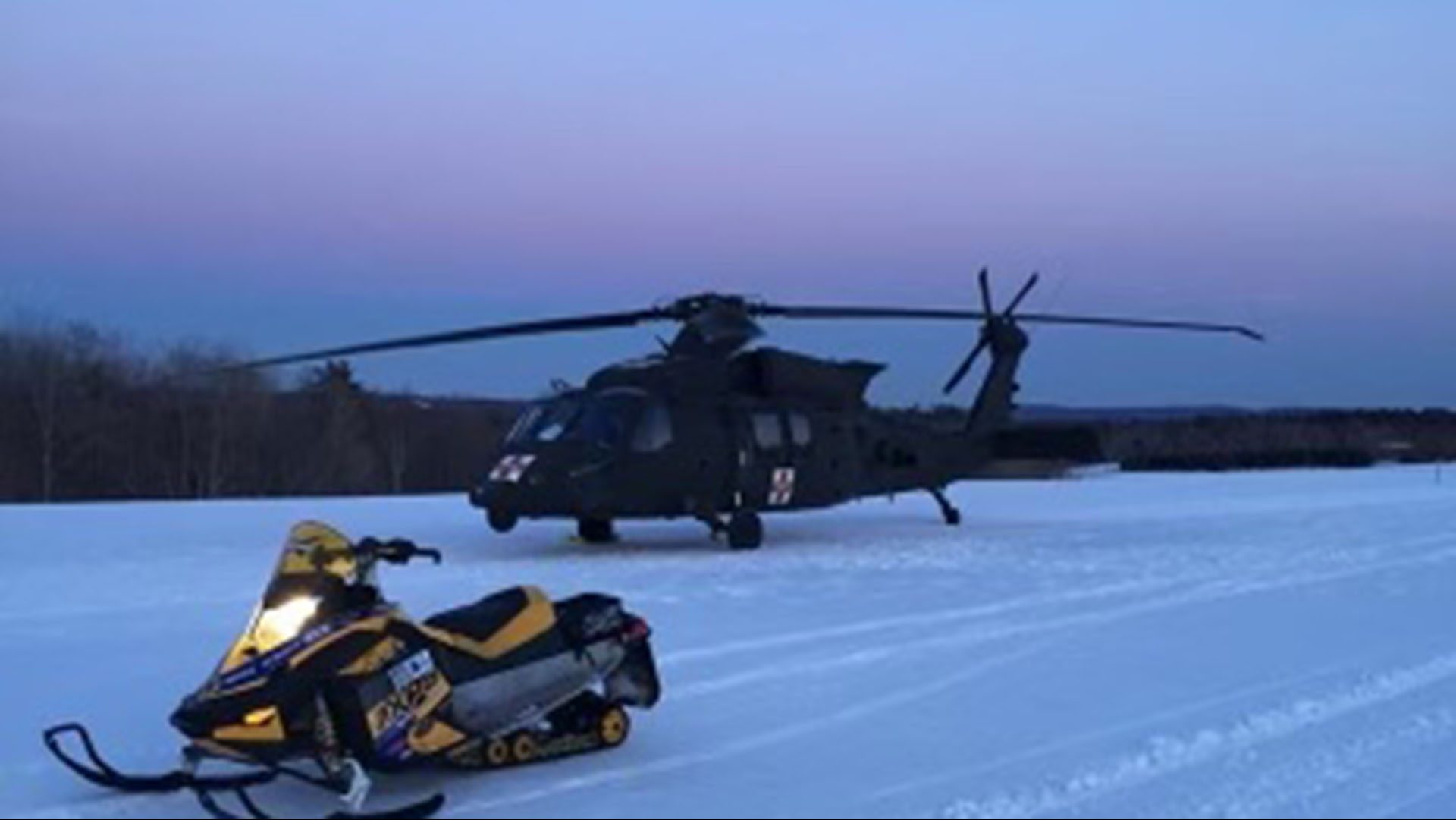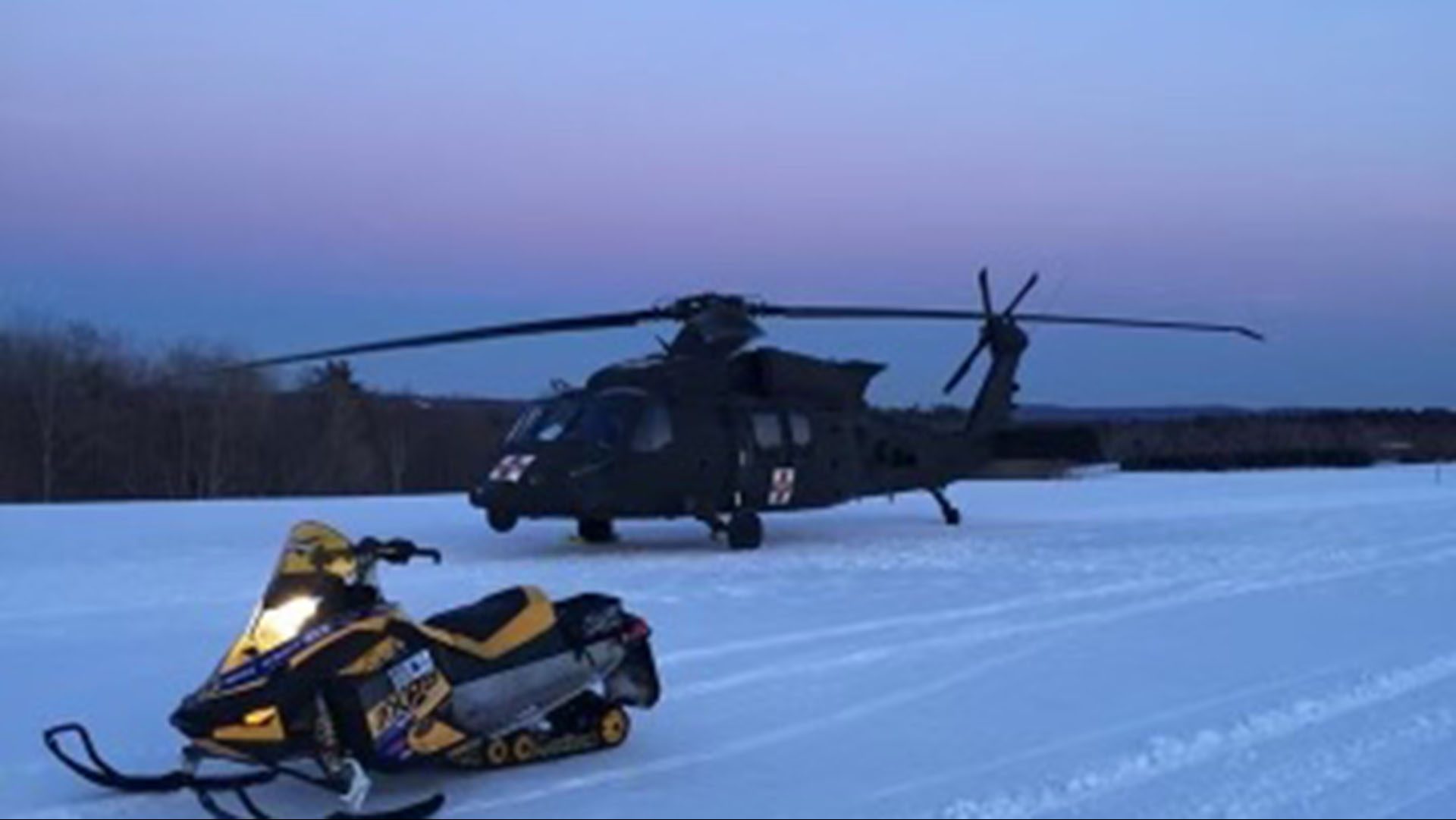

A judge has awarded a Massachusetts man more than $3 million after he was severely injured when he ran his snowmobile into a landed Army Black Hawk helicopter.
Jeffrey Smith struck the helicopter in March 2019 while driving at night and was thrown from the snowmobile. The helicopter, which was assigned to Fort Drum, New York, had touched down just before sunset on a rural airstrip in Worthington, Massachusetts that was also used as a snowmobile trail by local riders.
At the time of the incident, Smith had drunk two beers and taken prescribed medications — Adderall and Suboxone — that night, but a witness testified that Smith was not intoxicated when he set out on the snowmobile, according to court records.
In October 2019, Smith filed a lawsuit against the U.S. government seeking $9.5 million to cover medical bills, lost wages, and other expenses after striking the helicopter, which had landed on a snowmobile trail at night. As a result of the accident, Smith continues to suffer from a collapsed left lung, the nerve running his diaphragm is paralyzed, and he has no sensation in his left arm and hand, according to an earlier court filing.
On Monday, U.S. District Judge Mark G. Mastroianni determined that “the government is 60% responsible for the accident and Jeffrey is 40% responsible,” according to his decision, which was provided to Task & Purpose.
During the trial, an expert supporting Smith’s lawsuit testified that Smith was driving between 18 and 28 miles per hour when he struck the helicopter, but Mastroianni, the federal judge in the case, disagreed and ultimately sided with an expert for the U.S. government, who testified that Smith was likely driving at a speed that was “not prudent for the conditions.”
“The court finds the government breached its duty of care in failing to take any steps to protect against the obvious risk of a camouflaged helicopter parked on an active snowmobile trail, in a somewhat wooded area, as darkness set,” Mastroianni wrote in his ruling. “The helicopter and area where it was parked were not illuminated or marked in any way. However, the court also finds Jeffrey breached his duty to operate his snowmobile in a safe manner and avoid harm by, among other things, speeding and wearing tinted goggles at night.”
Mastroianni awarded Smith approximately $3.3 million in damages and a total of $250,000 to his son and daughter.
“We are grateful for Judge Mastroianni’s thoughtful consideration of the complicated facts of this case,” Douglas Desjardins, Smith’s attorney, told Task & Purpose on Tuesday. “ We believe justice was served, and the decision encourages public safety.”
Subscribe to Task & Purpose today. Get the latest military news and culture in your inbox daily.
It is unclear whether the government will appeal Mastroianni’s decision.
An Army spokesperson declined to comment on the ruling, saying, “As a matter of policy, the Army does not comment on matters in litigation.”
Pilot wanted to meet a friend
On March 12, 2019, the Army Black Hawk landed at the airstri in Worthington, Massachusetts as part of a training mission. The aircraft had landed before sunset, but after it became dark several snowmobilers began using the trail, including Smith.
Mastroianni determined that the instructor pilot who oversaw the Black Hawk’s training mission decided to land at the airstrip, in part, because it was close to where one of his friends lived, with whom he wanted to hang out. This was “not the usual practice on Army training missions,” the judge wrote, adding that he inferred that the rest of the helicopter’s crew was “somewhat annoyed” at having to take part in the instructor pilot’s social plans.
Before landing, the helicopter crew saw snowmobile tracks on the airfield. After the aircraft touched down, snowmobilers drove near the helicopter, but it was still daylight, and they could see the Black Hawk. The snowmobilers were also traveling at slow speeds between 5 and 10 miles per hour.
The crew then left the aircraft unattended to have refreshments with the instructor pilot’s friend, the judge found.
“During this time, no crew members were assigned to supervise the unlit and unmarked helicopter sitting directly on the snowmobile trail and none of them paid attention to it (although some of the crew testified unconvincingly that it remained in their sight),” Mastroianni wrote.
About 7:15 p.m. that night, another snowmobiler nearly ran into the helicopter while traveling between 30 and 60 miles per hour. He came within 15 to 20 feet of the Black Hawk’s tail but was able to swerve and avoid it. The snowmobiler also took a picture of the helicopter that showed how it was starting to blend in with the background as it grew darker.
“The crew, having worked on such dark-colored helicopters in the past, clearly would have understood this camouflaging effect,” Mastroianni wrote.
Smith had seen the helicopter prior to the crash
However, the judge also found that Smith had seen the helicopter after it landed on the airstrip at least once prior to the accident. One witness later testified that when she visited Smith in the hospital, he told her, “Shame on me, I knew it was there,” according to Mastroianni’s decision.
Mastroianni also found that Smith had stopped his snowmobile shortly before the accident to try to see the helicopter on the airstrip. Not seeing it, he then pushed the throttle of his snowmobile all the way forward and accelerated to between 65 and 70 miles per hour.
“Given his prior knowledge of the helicopter’s location, Jeffrey should have exercised more caution when driving up the runway,” Mastroianni found. On the other hand, the fact that he pulled off his goggles and still could not locate the helicopter illustrates that the helicopter’s dark color blended in with the forest and hills in the background.
The helicopter’s crew was preparing to take off at the time and the instructor pilot unsuccessfully tried to alert to Smith using a headlamp. Smith saw a glimmer of light reflecting from one of the helicopter’s steel parts, and he pumped on the brakes and tried turning, but he still hit the aircraft. Witnesses later testified that Smith was likely driving too fast to see the helicopter in time to avoid it.
As an experienced snowmobiler, Smith understood that it is possible to “outdrive” a snowmobile’s headlights by traveling too quickly to have enough time to brake and avoid an object, Mastroianni wrote.
“Had he been traveling at a safer speed, it is likely that he could have avoided the accident or at least suffered less serious harm,” Mastroianni wrote.
A preventable accident
The judge also determined that Smith was “at least slightly impaired” by the medications he had taken and alcohol he had drunk earlier that night. Smith was also wearing tinted goggles at the time, which blocked the little ambient light available.
“The court finds that Jeffrey’s speed, tinted goggles, and at least slight impairment — in addition to the darkness and the helicopter blending in with the trees — all played a role in his failure to see the helicopter until it was too late,” Mastroianni wrote.
Prosecutors initially charged Smith with operating under the influence of alcohol or drugs and, but the charge was later dismissed because the “Commonwealth did not believe it would be able to prove impairment due to a lack of evidence as to the defendant being under the influence at the time.”
Smith also later acknowledged that he was speeding when he drove on the airfield.
Still, Mastroianni determined that the helicopter’s crew had failed to rectify a dangerous situation after realizing they had landed in the middle of a snowmobile trail. One crew member could have remained with the aircraft with a light to alert any snowmobilers, the crew could have placed chemical lights around the Black Hawk to mark its location, or they could have asked local or state first responders for help when they realized they had landed in an active snowmobile trail.
He also found that the instructor pilot was “distracted” by meeting his friend when he should have been focused on reducing the dangers of having his helicopter parked in the snowmobile trail.
“The failure to adequately supervise the helicopter, after leaving it in a dangerous location, contributed to this preventable accident,” Mastroianni wrote. “Both parties were at fault here. But in assigning a percentage of blame, the court finds the United States is more at-fault than Jeffrey.”
